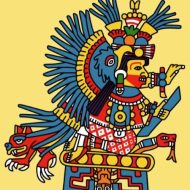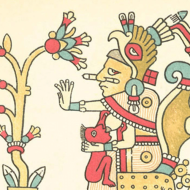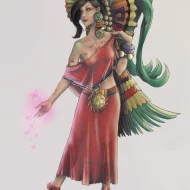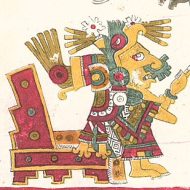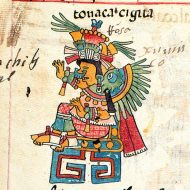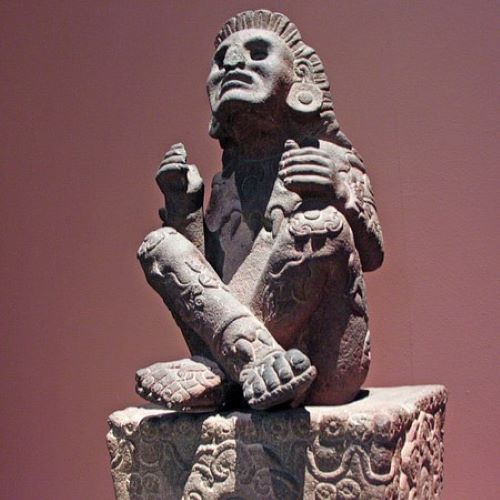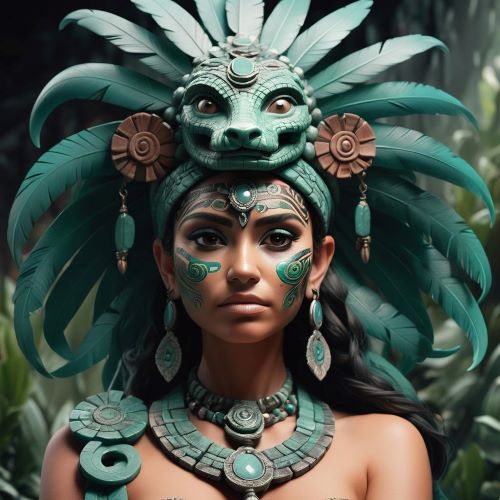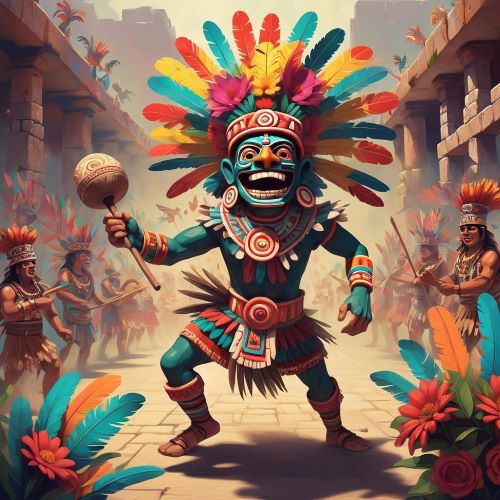Xochiquetzal : Goddess of Love
Listen
At a glance
| Description | |
|---|---|
| Origin | Aztec Mythology |
| Classification | Gods |
| Family Members | Coatlicue (Mother), Xiuhtecuhtli (Father), Xochipilli (Brother), Tlaloc (Husband) |
| Region | Mexico |
| Associated With | Love, Fertility Childbirth |
Xochiquetzal
Introduction
Xochiquetzal, also recognized by the name Ichpochtli, which signifies “maiden,” holds a revered place in Aztec mythology. This goddess is intricately linked with fertility, beauty, and love, assuming the roles of protector for young mothers and a patroness overseeing aspects like pregnancy, childbirth, as well as traditional crafts predominantly practiced by women, such as weaving and embroidery.
In the vibrant tapestry of creation and destruction, Xochiquetzal, the goddess of flowers, beauty, and love, gracefully dances. Her name, a poetic murmur in Nahuatl, translates to “precious flower,” eloquently capturing her dual nature – alluring and delicate, yet harboring a resilient strength that nurtures life and whispers of passion.
Physical Traits
In contrast to various other figures within the intricate array of Aztec female earth deities linked to agricultural and sexual fecundity, Xochiquetzal consistently appears as an enticing and youthful woman. She dons rich attire and carries symbolic connections to vegetation, notably flowers. Xochiquetzal manifests as a resplendent young woman adorned in vibrant clothing, including an ornate headdress, with flowers and gold jewelry enhancing her appearance. Her flowing black hair, interwoven with fragrant blossoms resembling a cascading waterfall, adds to her allure. Her eyes, reminiscent of jade pools, reflect the warmth of spring and the intensity of an impending storm, guarding the secrets of love and creation.
Clad in garments crafted from hummingbird feathers, Xochiquetzal’s attire signifies her ethereal connection, while her turquoise and jade ornaments emit delicate chimes akin to a garden paradise. Eschewing a scepter, she cradles a bouquet of the most exquisite flowers in her hands, their intoxicating aroma a perpetual reminder of her domain – the realm of beauty, sensuality, and burgeoning life.
Family
Xochiquetzal’s familial connections remain shrouded in mystery due to historical gaps wrought by the passage of time and conquest. Despite this, she shared significant relationships with various deities. Her twin brother, Xochipilli, held sway as the god of art, beauty, and dance. Xochiquetzal, in her divine role, assumed the position of wife to several Aztec gods, each embodying distinct realms of power.
Among her divine spouses were Piltzintecuhtli, associated with the rising sun, healing, and hallucinogenic drugs; Tlaloc, the rain god; Tezcatlipoca, one of the four creator deities and the omnipresent god of the night sky and thoughts; Centeotl, the god of maize; and Xiuhtecuhtli, the god of fire and heat. Xochiquetzal’s narrative intricately unfolds within the Aztec pantheon’s complex family dynamics.
As the daughter of the formidable goddess Coatlicue and the fiery Xiuhtecuhtli, she personified the essence of duality, where creation and destruction interweave seamlessly. Her twin brother, Xochipilli, the god of love, music, and games, shared her playful spirit and passion for the sensual aspects of life. Their connection, akin to the yin and yang, spotlighted the intrinsic link between love and destruction, joy and sorrow — two facets of a vibrant, interconnected coin.
Yet, Xochiquetzal’s familial bonds extended beyond her immediate circle. In a significant union, she was wedded to the formidable Tlaloc, the god of rain and lightning. This marriage symbolized the delicate equilibrium between life-giving water and its potentially destructive forces. Their tumultuous relationship, marked by both passionate love and destructive elements, mirrored the unpredictable nature of the natural world.
Later in her divine journey, Xochiquetzal found herself ensnared in the intricate web of deceit spun by Tezcatlipoca, the trickster god. This entanglement led to a sequence of dramatic events that resonated throughout Aztec mythology, leaving an indelible mark on the intricate tapestry of divine affairs. The goddess’s interactions with these varied deities underscored the complexities and dualities inherent in the divine realm, adding layers of intrigue to the mythological narrative.
Other names
Xochiquetzal is recognized by various names, including Xochiquetzalli, Xochitl, and Macuixochiquetzalli. An alternative appellation, Ichpōchtli, is derived from the term ichpōchtli, meaning “maiden” or “young woman.” These diverse names create a vibrant mosaic that captures the multifaceted nature of her divinity. Ichpochtli, with its connotation of “maiden,” alludes to her youthful innocence, while Xocotl Icxi, translating to “flower crown,” underscores her profound connection to the lush beauty she embodies.
Xochiquemanque, signifying “feather skirt,” conjures images of her ethereal grace, while Chantico, meaning “fiery serpent,” unveils a concealed, untamed ferocity beneath the surface. Each name acts as a brushstroke, contributing to the intricate and nuanced portrayal of this enchanting goddess.
Powers and Abilities
Xochiquetzal’s power mirrors the diverse and vibrant spectrum of the flowers she personifies. She harnesses the magic inherent in life itself, fostering the growth of crops and ensuring abundant harvests. With a gentle touch of her feathered fingers, she kindles the flame of passion and intricately weaves the threads of destiny between hearts. As the patron of artisanship and craftsmanship, she bestows her followers with skill and creativity, extending the beauty of her realm beyond the natural world. Xochiquetzal possesses the fiery wrath inherited from her father, Xiuhtecuhtli, capable of unleashing destruction when the delicate equilibrium is disrupted. Her connection to fire, symbolized by a serpent coiled around her neck, serves as a poignant reminder that beauty and passion, while enchanting, can also be volatile.
In her divine role, Xochiquetzal was revered as the goddess of erotic love, fertility, and household arts like weaving and childbirth. Her strong association with flowers further enhanced her divine presence. As the goddess of love, she exuded an undeniable seductive allure. Xochiquetzal also wielded the power to forgive sins, becoming the focal point of a significant confession ritual conducted annually. This multifaceted portrayal underscores the goddess’s influence in matters ranging from love and fertility to the intricacies of household arts and the spiritual cleansing of sins.
Modern Day Influence
Xochiquetzal’s enduring legacy resonates in the profound impact of her symbolism and mythology on present-day Mexican culture. Her associations with love, beauty, and fertility persist as wellsprings of inspiration for artistic endeavors. In contemporary art, festivals, and cultural events, her imagery is frequently integrated, breathing life into creative expressions that echo the timeless essence of Xochiquetzal. Across the span of centuries, her influence continues to flourish in unexpected corners of the world.
The vibrant Mexican holiday, Día de Muertos, serves as a poignant testament to the enduring relevance of Xochiquetzal’s legacy. Rooted in Aztec beliefs, this celebration mirrors the goddess’s role as the protector of young mothers and the patroness of childbirth, embodying a tradition of honoring the deceased. As contemporary Mexican culture evolves, Xochiquetzal’s imagery remains a wellspring of inspiration, enriching the realms of art and literature. The celebration of her connection to natural beauty and passionate living resounds in the vibrant tapestry of modern Mexican expressions, a testament to the timeless allure of this divine figure.
Related Images
Frequently Asked Questions
What is lorem Ipsum?
I am text block. Click edit button to change this text. Lorem ipsum dolor sit amet, consectetur adipiscing elit. Ut elit tellus, luctus nec ullamcorper mattis, pulvinar dapibus leo.
What is lorem Ipsum?
I am text block. Click edit button to change this text. Lorem ipsum dolor sit amet, consectetur adipiscing elit. Ut elit tellus, luctus nec ullamcorper mattis, pulvinar dapibus leo.
What is lorem Ipsum?
I am text block. Click edit button to change this text. Lorem ipsum dolor sit amet, consectetur adipiscing elit. Ut elit tellus, luctus nec ullamcorper mattis, pulvinar dapibus leo.
What is lorem Ipsum?
I am text block. Click edit button to change this text. Lorem ipsum dolor sit amet, consectetur adipiscing elit. Ut elit tellus, luctus nec ullamcorper mattis, pulvinar dapibus leo.
What is lorem Ipsum?
I am text block. Click edit button to change this text. Lorem ipsum dolor sit amet, consectetur adipiscing elit. Ut elit tellus, luctus nec ullamcorper mattis, pulvinar dapibus leo.

